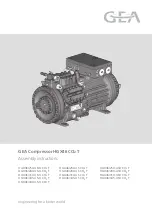
MAINTENANCE
37
HP935, VHP750, MHP825, XHP750, XP1060
CAUTION: If inspection reveals damage to the main element, the
safety element must be replaced.
Check the seal at the end of the element and replace if any sign of
damage is evident.
Reassembly
Assemble the new element into the filter housing ensuring that the
seal seats properly.
Secure the element in the housing by hand tightening the nut.
Assemble the dust collector box parts, ensuring that they are
correctly positioned.
Before restarting the machine, check that all clamps are tight.
NOTE: In the event that a new filter element is not readily available, the
element can be re–used after cleaning. In this case the following
procedure must be carried out:
Clean the element by directing a jet of clean, dry compressed air,
no more than 5 bar, at an angle of 45 degrees to the outside of the
element. Carefully blow any dust from each fold of the element.
Compressed air cleaning is only recommended when a new
element is not available.
CAUTION: Safety elements must not be cleaned and re–used.
VENTILATION
Always check that the air inlets and outlets are clear of debris etc.
CAUTION: NEVER clean by blowing air inwards.
COOLING FAN DRIVE
Periodically check that the fan mounting bolt in the fan hub has not
loosened. If, for any reason, it becomes necessary to remove the fan
or re–tighten the fan mounting bolt, apply a good grade of commercially
available thread locking compound to the bolt threads and tighten to the
torque value shown in the TORQUE SETTING TABLE later in this
section.
The fan belt(s) should be checked regularly for wear and correct
tensioning.
FUEL SYSTEM
The fuel tank should be filled daily or every eight hours. To minimise
condensation in the fuel tank(s), it is advisable to top up after the
machine is shut down or at the end of each working day. At six month
intervals drain any sediment or condensate that may have
accumulated in the tank(s).
FUEL FILTER WATER SEPARATOR
The fuel filter water separator contains a filter element which should
be replaced at regular intervals (see the SERVICE/MAINTENANCE
CHART).
Caterpillar powered units are equipped with primary and secondary
fuel filters.
CHARGE COOLER PIPEWORK:–
Inspect all hoses and clips on the charge cooler pipe work.
Engine damage will occur if the charge cooling system leaks.
HOSES
All components of the engine cooling air intake system should be
checked periodically to keep the engine at peak efficiency.
At the recommended intervals, (see the
SERVICE/MAINTENANCE CHART), inspect all of the intake lines to
the air filter, and all flexible hoses used for air lines, oil lines and fuel
lines.
Periodically inspect all pipework for cracks, leaks, etc. and replace
immediately if damaged.
ELECTRICAL SYSTEM
WARNING: Always disconnect the battery cables before
performing any maintenance or service.
Inspect the safety shutdown system switches and the instrument
panel relay contacts for evidence of arcing and pitting. Clean where
necessary.
Check the mechanical action of the components.
Check the security of electrical terminals on the switches and relays
i.e. nuts or screws loose, which may cause local hot spot oxidation.
Inspect the components and wiring for signs of overheating i.e.
discolouration, charring of cables, deformation of parts, acrid smells
and blistered paint.
BATTERY
Keep the battery terminals and cable clamps clean and lightly
coated with petroleum jelly to prevent corrosion.
The retaining clamp should be kept tight enough to prevent the
battery from moving.
PRESSURE SYSTEM
At 3 month intervals it is necessary to inspect the external
surfaces of the system (from the airend through to the discharge
valve(s)) including hoses, tubes, tube fittings and the separator tank,
for visible signs of impact damage, excessive corrosion, abrasion,
tightness and chafing. Any suspect parts should be replaced before
the machine is put back into service.
TYRES/TYRE PRESSURE
See the GENERAL INFORMATION section of this manual.
RUNNING GEAR/WHEELS
Check the wheel nut torque 20 miles (30 kilometres) after refitting
the wheels. Refer to the TORQUE SETTING TABLE later in this
section.
The bolts securing the running gear to the chassis should be
checked periodically for tightness (refer to the
SERVICE/MAINTENANCE CHART for frequency) and re–tightened
where necessary. Refer to the TORQUE SETTING TABLE later in this
section.
Содержание HP935
Страница 22: ...GENERAL INFORMATION MSA SRG HRG 20 HP935 VHP750 MHP825 XHP750 XP1060 SRG HRG...
Страница 46: ...MACHINE SYSTEMS 44 HP935 VHP750 MHP825 XHP750 XP1060 CONTROL SYSTEM SCHEMATIC...
Страница 59: ......
Страница 60: ......
Страница 61: ...Printed in the United Kingdom...
















































